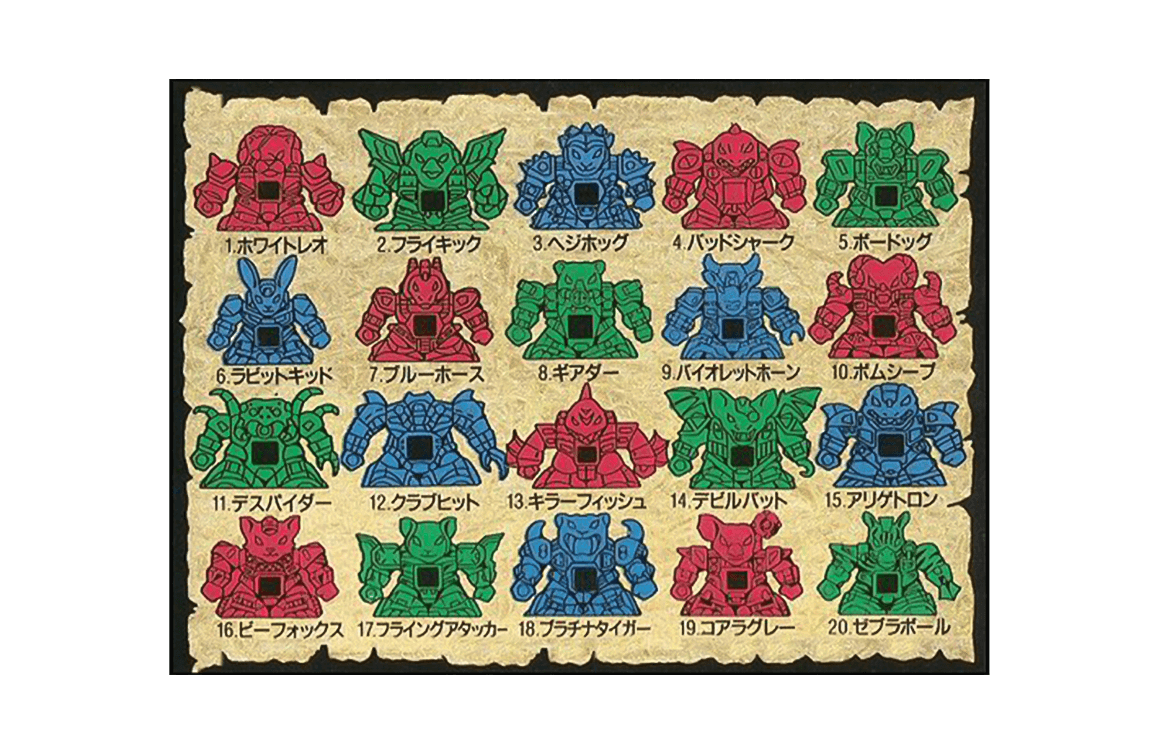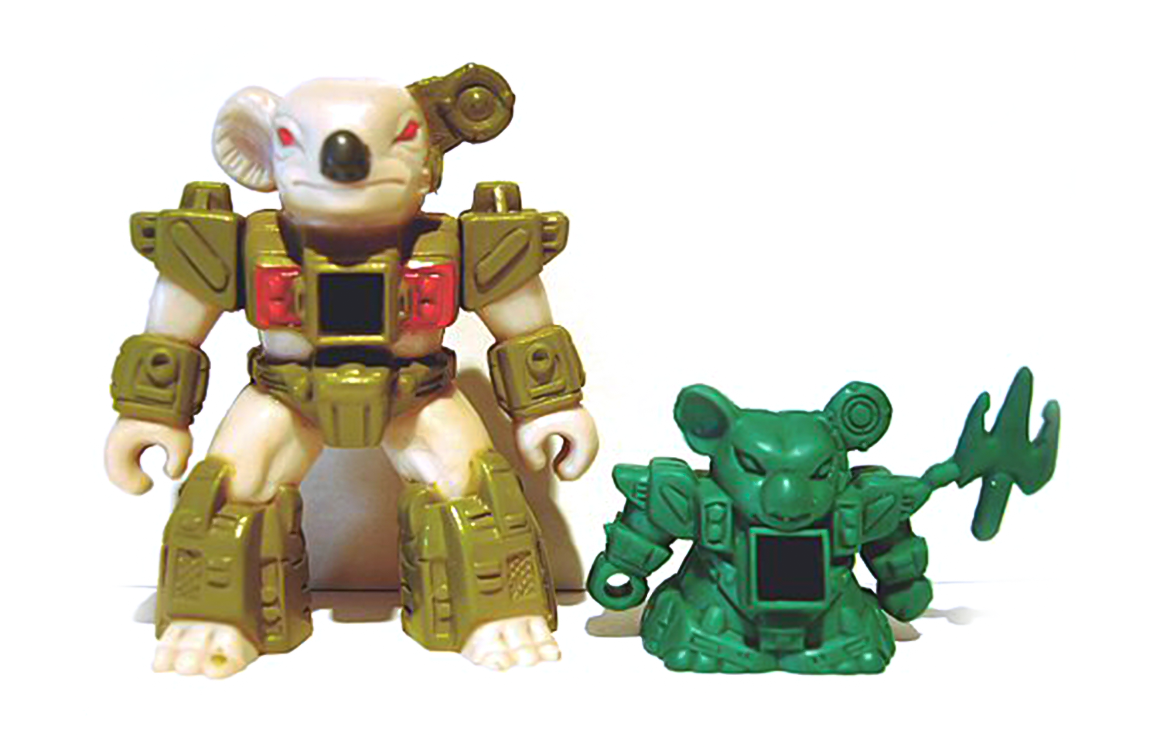How do you describe your collection?
First of all, I want to say that I am honoured and humbled to be the focus of your Collector Spotlight. Collecting toys has brought me a lot of joy over the years, and I appreciate this opportunity to share my joy with others.
Throughout my collecting journey, I have primarily collected vintage, loose, mint, mono-coloured miniature figurines, also known as keshigomu. Keshigomu, or keshi, is a Japanese term for collectable miniature rubber figures. Because there does not appear to be an equivalent Western term but many Western toy lines that fit this description, I often use the term when referring to Western toy lines as well.
I currently collect four toy lines:
Bad Eggz Bunch made by Lewis Galoob Toys Inc in the early 1990s. They were released in Europe and came in soft and hard material. I collect the hard material variant. These figures were sculpted by the super talented James Groman. There are 24 unique sculpts eeach in 5 colourways.
Garbage Pail Kids Cheap Toys Series 1 made by the Topps Chewing Gum Inc. in the late 1980s. They were released in the UK, Canada, and the US (and possibly elsewhere). They came in at least three varieties of material. I’m not sure who sculpted them, although I would absolutely love to know. There were 10 unique sculpts in at least 20 recognized colourways each.
I also collect Dr. Slump and Morinaga SD Gundam with Pilot keshigomu. These lines were produced in Japan and, as with most keshigomu toy lines, are based on popular manga and anime franchises. These franchises originated in the early ’80s and remain popular today. My knowledge of these toy lines is limited, but I’m sure they are well-documented somewhere out there on the interwebs! I would love to know who sculpted these lines, too.
When and why did you start your collection?
When I was growing up in the ’80s, I was able to assemble a large collection of M.U.S.C.L.E. figurines by trading random toys with my neighbourhood friends. My mom refused to buy me any because they were too weird and appeared to be low quality relative to other toys on the market, such as G.I Joe and Star Wars (of which I also had many). However, I spent hours playing with my M.U.S.C.L.E. toys, naming them, arranging them into tribes, staging battles, etc. I’ve learned that my story is not unique. Despite there being a vast number of unique sculpts, there was almost no information about the characters. There was no substantive Western comic book, cartoon, or storyline. Kids had to fill in the blanks with their imagination.
When I was in graduate school in the 2000s, I discovered Nathan’s MUSCLE Page and the American Kinnikuman Information Archive. Through these wonderful resources, I learned that the M.U.S.C.L.E. sculpts were “borrowed” from the incredibly popular Japanese Kinnikuman franchise, consisting of a manga, anime, a keshi toy line, and more. The discovery was nothing short of mind-blowing, thrilling, and, well, expensive.
Even though I was living off pasta at the time, I was hooked, and I became an avid collector of any and all Japanese and Western keshi toy lines I could find, vintage and in production. I soon also learned that the Western Battle Beast toy line was the derivative of a Japanese toy line called BeastFormers, and that the ubiquitous Garbage Pail Kid cards had a keshi toy line of their own called Cheap Toys.
I understand that keshigomu are an acquired taste. Many toy collectors look at them as the cheap, disposable collectable they were intended to be. No articulation, no paint applications, minimal accessories, and cheap materials. I get it. I can only assume my interest is grounded in my nostalgia for the M.U.S.C.L.E. toy line. But that’s not an apology, haha.
Keshi, as they were designed to be, are highly collectable. They are small, making them easy to mail, store, and display. They are durable, as they do not typically have moveable, breakable parts. The mono colours allows for greater emphasis of the craftsmanship of the sculpting, which is sometimes lost beneath paint applications. The lack of paint applications allows also for a variety of colours, including transparent, neon, and even glitter-filled varieties. There’s a lot to love about keshigomu. They also often appear in huge, mixed lots in online auction websites which are fun to purchase and dig through for hidden gems.
When I began collecting these toy lines, little was known about many of them. They were still relatively inexpensive. My fellow collectors and I spent hours hunting, discovering, discussing, and documenting these toy lines via the internet, eBay, Yahoo Japan auctions, and toy forums such as AKIA, Beastformers, Garbage Pail Kids Underground, and Little Rubber Guys. We speculated about mysterious, one of a kind figures, sculpt variations, colour variations, sculpt alterations, alternative trade markings, and learned a lot about the injection molding process. It was so much fun, but sadly not without its fair share of drama.
In many cases, sharing what we learned about these toy lines and documenting them online in the form of archives and articles caused new collectors to join the hunt, which resulted in prices skyrocketing. But I don’t have any regrets and I would do it all again.
Please humour me while I take a moment to shout-out some of the many interesting people I encountered along the way: Johnny, Nathan, Chad, Marty, Doc, Alex, Eric, Matthew, Tyler, Nico, Cory, Midas, Rusvan, Jason, Gakman, and many others.
How do you display and store your collection?
I made the decision several years into my collecting journey to collect only vintage toy lines and, generally, only to the extent that I could display them. I display my collection in wall-mounted cases custom-made by fellow keshi collector and sculptor Eric Nilla. I also use a variety of large glass jars.
I have also, almost from the start, made a practice of photographing my collection and sharing images on toy forums, self-made archives, Flickr, and most recently Instagram. I consider this a form of “displaying my collection.” There are a vast number of collectors with amazing collections which, for a number of reasons, are stored underneath their beds in boxes, never to be experienced nor enjoyed by fellow collectors.
I have most often used threads in toy forums to track my collections, which is a fun and convenient way to let other collectors know what pieces you need. For many of the toy lines I’ve collected, the number of sculpts and colourways has been unknown. Documenting my collections via visual archives has doubled as a way of keeping track of them.
What do you consider to be the Holy Grail of your collection?
The Holy Grail of my collection has to be the complete set of all 24 Bad Eggz Bunch sculpts. It took over a decade to assemble, although my focus certainly waned off and on from 2010 and beyond. A very, very close second is complete sets of Orange and Neon Green series one Cheap Toys.
Another Holy Grail of sorts for me was a discovery I made related to the M.U.S.C.L.E. toy line. Long story short, the line consists of 236 unique sculpts and 10 colourways. No individual sculpt was made in each of the 10 colourways. For purposes of tracking one’s collection, then, we sought a pattern or mechanism to determine in which colourways each individual sculpt would have been made. I was able to establish that the injection molds used for the M.U.S.C.L.E. toy line consisted of approximately 7-10 unique sculpts each. Thus, all the sculpts in a particular mold would be available in the same colourways. So if sculpt X from mold Y was found in, say, red, we could infer that all other sculpts belonging to that mold would be available in red as well. This still did not tell us which molds were made in which colourways, and more importantly, why! It’s possible much more has been discovered about the M.U.S.C.L.E. toy line–in fact, I hope so!
One other notable highlight of my collecting journey was having one of the creators of the Kinnikuman franchise “like” one of my Instagram posts featuring a Kinnikuman figure!
What advice would you give to someone interested in starting a similar collection?
Over the years, I’ve seen many collectors enter the scene and many collectors leave the scene. Some of us have spent considerable time thinking about and discussing why people begin collecting and stop collecting. Of course, people collect all manner of things, not just toys.
One bit of advice I would give collectors is to be intentional about their collecting habits. When I first discovered the world of keshi, I bought everything in sight. Soon, I had boxes filled with pieces from dozens of random toy lines, toy lines from all over the world, some vintage and some still on store shelves. I didn’t have a plan. I had no goals. I had no limit on what I was willing to spend on a particular figure or toy line. As time went on, I found my collecting to be most meaningful when I set goals and parameters, such as getting one of each sculpt from a particular line, or getting one particular sculpt in each colourway, or focusing on only loose, mint, complete pieces, and not mint-on-card.
I also supplemented my collecting with other activities involving the toy lines I collected, such as photographing pieces and creating archives, being active in forums, trading, trying my hand at sculpting figurines, and documenting various toy lines in blog posts.
I also came to believe that the joy of collecting was in the journey, not the destination. In other words, the process of hunting down a particular piece is just as enjoyable as having the piece sitting on my toy shelf! I’ve known multiple collectors who’ve completed a set, sold it, then attempted to complete it again.
And of course, take time to get to know your fellow collectors and treat them with respect. Although I have strived to maintain my anonymity in the collecting sphere of my life, I still made connections with fellow collectors that I consider genuine friendships. A large part of the joy I’ve found in collecting has come from these interactions and friendships!
More practically, collecting a vintage toy line that is no longer in production and that was produced in another country means you’ll want to network with fellow collectors. Doing the majority of your collecting through online auction websites is not ideal. You’ll want to establish a network of trustworthy partners with whom you can trade, sell, and buy. Instagram and the Little Rubber Guys forum are great places to get started.
I want to thank Joanna and Toy Tales for giving me this opportunity to share my collecting story and, of course, to spotlight my collection.
Enjoy exploring the many links offered by Soupie in this edition of Collector Spotlight.
Drop us a line to let us know about your collection of vintage toys and/or games. We just may feature your collection!









